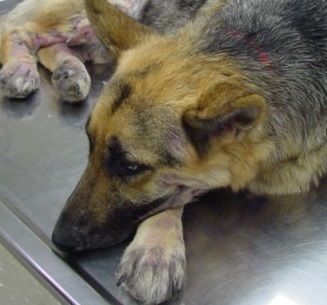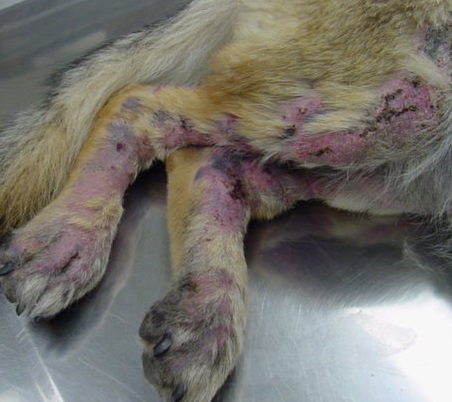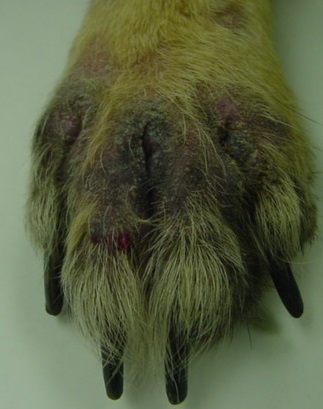Pet Case Study: “Magnolia” a Dog Licking Excessively
Magnolia is a 3-year-old female German Shepherd dog with a history of progressive paw licking, red skin, and hair loss. The clinical signs worsened while she was having her heat cycle. The owners reported “….she seems to be uncomfortable all the time and feels bad.” Dr. Seals suspected an overgrowth of the mite “Demodex canis” to be the cause of the skin changes. Samples of hairs were plucked from the paws and a skin scrape was collected for microscopic evaluation.

Magnolia seemed uncomfortable and had multiple bald spots on the face and paws.
Demodicosis is also known as red mange. The mite Demodex canis is a mite that normally resides in the dog hair follicle in small numbers. The mite is not contagious to people or pets. Its overgrowth can cause localized or generalized skin changes. When a dog develops clinical signs from an overgrowth of these mites it can be linked to genetics, age, poor nutrition, lack of shelter, impaired immune-system, medications, and/or the estus cycle of a female dog. Dogs with many mites of all life stages and progressive symptoms need anti-mite therapy. Whereas, localized symptoms usually resolve without treatment. Around 95% of patients that require therapy will resolve the mite and therapy can be discontinued. About 5% of patients will require therapy for life. It is recommended that affected female dogs be spayed. Adult dogs require additional tests to determine if a systemic illness is present which can lead to a weakened immune system and consequent proliferation of the mite.

The paws were warm to the touch, red, and the hairs were falling out in several areas.

A close up of an affected paw shows redness and thickening of the affected skin and hair loss.
The recommended treatment varies between patients based on their age, breed, and underlying conditions. Treating a secondary bacterial infection is also required. It can take several months of therapy for the mite infection to resolve.

Microscopic evaluation from the skin scrape revealed several long bodied organisms, Demodex canis.
For Magnolia, after receiving the appropriate treatment the Demodex canis infection cleared. The therapy was discontinued and she continues to do well. In her case, she was spayed in addition to anti-mite therapy. An underlying systemic condition was not present.

Magnolia looks and feels more like her normal self after receiving therapy.
If you have questions about a pet with similar skin changes in your household please contact ADRC to schedule an appointment.
- Oct, 30, 2019
- Case Studies

